A few years ago, I decided to write an article about milk and all of its controversies with one goal in mind: to see if I should be giving my kids milk or not, and if so, which kind.
In that article “The Dairy Debate”, I discussed the general topic of pasteurization, the differences between conventional, certified organic and raw milk, and also touched on the different types of cows and the genetic mutation that occurred over the years.
But in the end, I was left with more questions than answers about milk.
Do all factory dairy farms run their businesses in filthy conditions, artificially impregnating their cows year-round, and injecting their cows with hormones and antibiotics?
Are all dairy cows fed GMO grains instead of being allowed to graze the pasture? What about smaller scale operations?
What about our local brands of milk like Marmum, Al Rawabi or Al Ain? Are they any better?
It was time for more specific answers so I set off to find out…
As a starting point, I came up with a list of questions to ask the different milk manufacturers, which were the following:
1. What type of cows do you have? (To determine if it’s an A1 or A2 cow)
2. What is their living condition like when not being milked? Or are they always being milked?
3. What is their typical diet? What are they fed and if given a mixed feed, what is the ratio/percentage of each ingredient? And is their feed genetically modified or GMO-free?
4. Are they given any antibiotics? To my knowledge, a cow that is fed something other than its natural diet of grass, will develop infections and require antibiotic treatments.
5. Are they given the recombinant bovine growth hormone (rBGH) to produce more milk?
6. And finally, are visitors allowed to visit the dairy farm to see the cows and milk production process?
I figured that an ethical company that prides itself on quality should be forthcoming and transparent.
Some companies immediately replied, others were less responsive and questioned my motives, and unfortunately one simply never got back to me despite numerous phone calls, emails and text messages.
As a consumer, I feel privy to this information and have only one goal in mind: to determine what is best for my family.
I do need to point out however that there might be errors or gaps in the table below as it was sometimes difficult to get the requested information.
Below is a summary of my findings. Click for a larger view:
Looking at the positives first, it is against UAE law to use growth hormones in livestock therefore none of the companies here use these practices. A big plus compared to the US where these practices are legal and in use.
Second, all of the companies attested to NOT using genetically modified feed. While this is good news, I am still somewhat skeptical because of the fact that the mix of grains is amongst the top “Big 5” GMO crops worldwide, namely, corn, soy, canola, cotton and beet.
Over 60 countries worldwide, including all of the countries of the European Union, Australia and Japan require GM foods to be labeled.
Many countries have even taken the initiative to ban GMOs altogether including our neighboring country Saudi Arabia.
What remains unclear however is whether or not Saudi Arabia applies the ban to animal feed because Argentina ranks among the top 3 GMO crop-growing countries in the world.
Unfortunately, the UAE does not impose such policies at the present time.
Regardless, it would still be nice to see the GMO-free label on the dairy farmer’s websites and products if their animals are in fact fed a GMO-free diet.
This is actually something positive and should be communicated to consumers!
Nevertheless, I am going to give them the benefit of the doubt and trust what they are saying, but just wanted to be completely honest about the doubts that I still have.
I was also hoping that some of these local companies would let their cows eat a variety of fresh grasses, but I think it was a bit naïve of me (especially that we live in the desert) to expect that they can be producing such massive quantities of milk while following the same practices that smaller farms used prior to the industrial revolution in the 1800’s.
Call me a dreamer!
My major concerns with grain-fed cows are:
1) Their susceptibility to developing bacterial infections, which require antibiotic and other medical treatments (but luckily all of the companies test samples for residues and discard the milk if any are found).
2) The quality of the milk.
There is a close relationship between the quality of our food and the environment in which it grows in.
Much like the quality of fruits and vegetables depends on the quality of the soil and air, and the purity of the water, the same is true for cows and their milk.
Their lifestyle, such as having access to pasture, fresh air, and clean water, as well as their diet all affect the quality of their milk.
Research studies show clear nutritional advantages from milk and milk-products like yogurt and cheese that come from organic pasture-raised, grass-fed cows.
They contain better quality fats; more omega-3, a better ratio of omega-3 to omega-6 fats, more conjugated linoleic acid, and higher quality saturated fats. They also include increased amounts of vitamin A (in the form of beta carotene), E, and other nutrients.
Unfortunately, unless we can find a small-scale local farmer who follows the more traditional farming practices, it’s just a modern-day fact that the quality of mass-produced milk today is taking a hit.
As to not single-out dairy farms alone, the same can be said about the decrease in the quality of the soil in farmlands too and today’s need for nutritional supplementation. But that’s another topic altogether…
Is Organic Milk Better?
Let’s look at the facts. By definition, certified organic means that a food must be free from:
♦ antibiotics
♦ genetically modified ingredients
♦ growth hormones
♦ pesticides, insecticides and herbicides
♦ sludge- or petroleum-based fertilizers
Given the fact that the UAE bans the use of growth hormones and given the fact that the local companies use non-GM ingredients, as well as discard milk found to have antibiotic residues, it seems that the remaining advantages to organic milk are the lack of pesticides and chemical-based fertilizers from an organic feed.
Let me explain this a little bit differently. Both types of milk – conventional and industrial organic – come from cows that are fed grains (i.e. not their natural diet).
The difference is that organic grains are pesticide and GMO-free, whereas conventional grains may be GM-derived and laced with chemical pesticides.
And of course there are no guarantees that conventional milk will never contain traces of antibiotics despite the companies’ efforts to discard medicated milk.
The possibility of mistakes and oversights can always happen.
Therefore, organic milk does have that advantage over conventional milk; the extra reassurance of being free from antibiotics and chemical pesticides.
The quality however, may not differ that much in my opinion since both types of cows are being given a grain-based diet which is not their natural diet.
But then again, I don’t want to generalize because the type of feeds and ratios vary from one farm to another.
What about organic pasture-raised milk?
In theory, yes, organic milk from cows that are allowed to graze green pasture and be free from all of the above listed items would be far superior. This is nature at its best. But here’s the catch.
All commercially-produced milk, regardless if organic or not, MUST be pasteurized in order to be legally sold in the UAE, which raises another point of concern – pasteurization and homogenization!
Pasteurization & Homogenization 101
Legally, all fresh milks sold in the UAE are pasteurized.
And according to my own investigative research, all conventional non-organic fresh milks sold in the UAE are also homogenized.
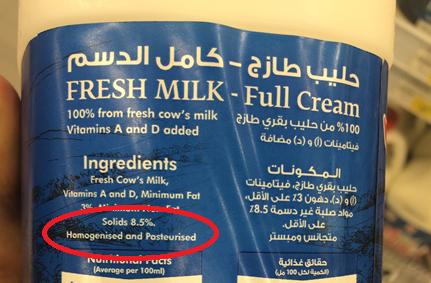
Without going into too much detail here, pasteurization (a process of heating milk to high temperatures) ensures that pathogenic bacteria and organisms are killed off to prevent food-borne illnesses.
From a nutritional standpoint however, pasteurization not only kills off the bad bacteria, it also kills the beneficial bacteria (i.e. probiotics), oxidizes fats, denatures proteins (i.e. they become unusable), and destroys most enzymes needed to digest the milk (i.e. lactase for the absorption of lactose; galactase for the absorption of galactose; phosphatase for the absorption of calcium).
This is the primary reason why so many people are intolerant to milk. Also, the dead cell fragments from the killed off bacteria remain in the milk and trigger immune responses, which are a major cause of milk allergies.1
The enzyme needed to break down fat (i.e. lipase) also gets destroyed which impairs the ability to properly absorb vitamin D, which is the main reason for fortification in commercial milk.
There is also a loss of up to 66% of fat-soluble vitamins A and D, an excess of 50% loss of vitamin C and complete destruction of vitamins B6 and B12. Heat affects water soluble vitamins and can make them 38 percent to 80 percent less effective.2
Pasteurization clearly leads to less healthy milk.
Homogenization on the other hand is a separate process that keeps milk fat from clumping and floating to the top by using a high-pressure process that breaks down the fat into tiny particles so that they don’t form a layer of cream at the top.
Homogenization requires high heat and high pressure which turns a good fat into a rancid fat. The process of homogenization seems so unwarranted to me. A good shake of the bottle before pouring a glass of milk can do the trick instead!
And although the research still isn’t really clear on this point, there may be a link between homogenization and the incidence of heart disease.3
So why do they do it? A quick google-search had this to say:
“It’s advantageous for large-scale dairy farms to homogenize milk because the process allows them to mix milk from different herds without issue.
By preventing cream from rising to the top, homogenization also leads to a longer shelf life of milk that will be most attractive to consumers who favor milk without the cream layer.
This allows large farms to ship greater distances and do business with more retailers.
Finally, homogenization makes it easier for dairies to filtrate out the fat and create two percent, one percent and skim milk.4
In my opinion, this extra step which has nothing to do with food safety sounds to be more beneficial to a company’s bottom line than it does to the consumer.
I did come across a few brands in the US while travelling this summer that were non-homogenized; therefore I believe it would be possible for companies here to start producing non-homogenized milk if there was enough consumer demand for it.
I for one would prefer non-homogenized milk for my kids if given the choice.
What about the UHT, Long Life, Shelf Stable milk?
Below is a summary of the different pasteurization processes (click for larger view):
Source: adapted from 100DaysofRealFood.com blog
If we compare the differences between pasteurization and ultra-pasteurization, the obvious difference is the amount of heat and the amount of time the milk is heated.
What is not so obvious is the magnitude of nutritional damage that occurs when heating the milk to such extreme temperatures during ultra-pasteurization; temperatures well beyond boiling point!
To me, it would make sense that the chemical changes in milk would only get worse during the Ultra High Temperature (UHT) process – regardless if the milk was organic or not.
All of the scholarly papers and articles5,6,7,8,9 that I read through confirmed my assumption and make it easier for me to decide to keep my family away from UHT, sterilized, ultra-pasteurized milk – organic or not!
Many of the organic milks that I found in the health food stores here in Dubai, regardless if the source was from a grass-fed cow, are ultra-pasteurized and will be labeled as UHT.
These are typically found in TetraPack cartons and may or may not be found in the refrigerator section. The same goes for conventional UHT milk in the supermarkets.
I find this to be a bit deceiving as it gives the impression that the milk is “fresh” when in fact it can last unopened on the shelf for up to 6 months and is the most denatured type of milk.

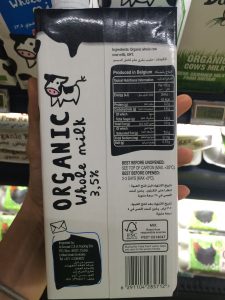
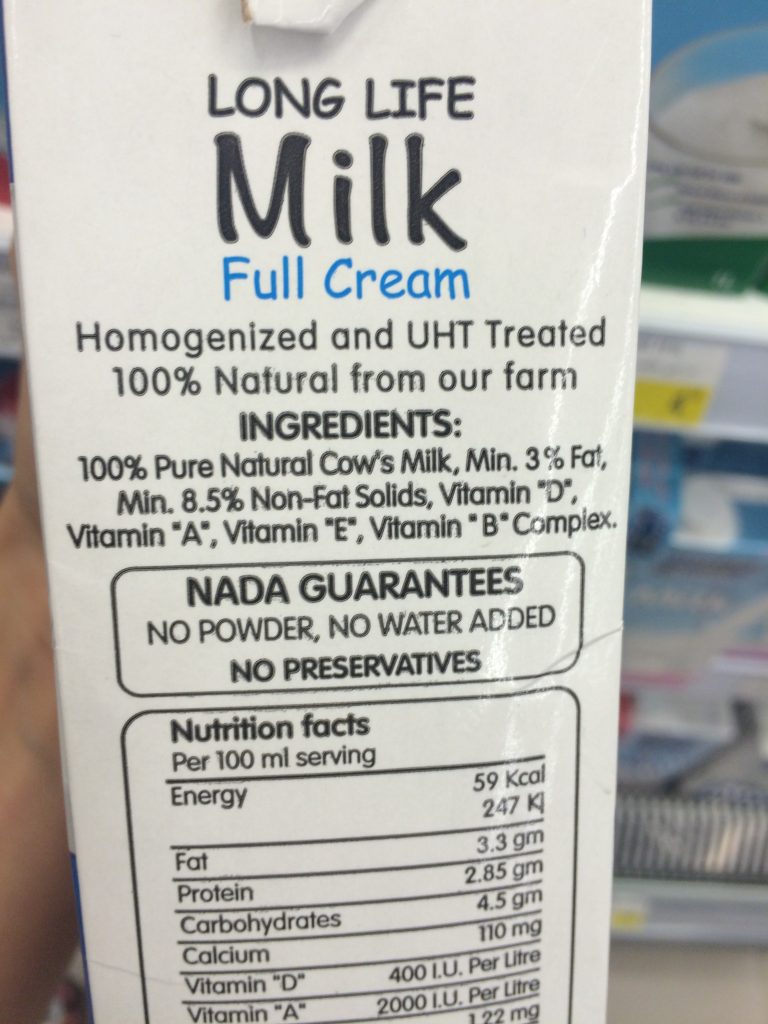
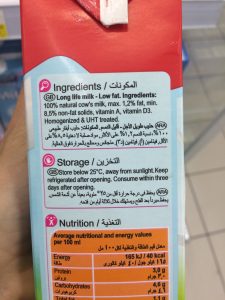
What about Raw Milk?
Raw milk for commercial use is illegal in the UAE. However, I have confirmed with the Dubai Municipality that raw milk is allowed for non-commercial use. Therefore, if we can find a local farmer who is willing to share their milk, it is perfectly legal.
We can also import from abroad up to 20 kg of raw milk per shipment for personal non-commercial use, as long as we fill out the necessary documentation and undertaking. More information can be found on their website under Food Safety Department and the import requirements document.
This definitely opens up more options! And if possible, I would consider bringing in frozen milk to prevent it from spoiling or affecting the quality.
Apparently, freezing milk has no effect on the nutritional status of milk as compared to pasteurization above 48oC (118oF); the temperature at which milk proteins begin to denature.10,11
I know that non-milk drinkers will strongly disagree with me at this point, but I believe in bio-individuality and ancestral ways of eating.
For centuries, there have been cultures and societies that have thrived on raw milk and dairy products from all types of animals (i.e. way before factory farming and large dairy operations) and I find this fact very difficult to ignore.
If we could find a good clean source of pasture-raised organic raw milk, why would it be any different for us today? (More on this later …)
The main concern with raw milk is its safety.
However, statistically speaking, the incidence of drinking contaminated milk is rare.12
In 2009, the FDA excluded raw milk from their top 10 riskiest foods. Believe it or not, fresh leafy greens were the number one riskiest foods followed by eggs and tuna.13
Understandably, the problem with raw milk is that if you do happen to drink contaminated milk, the consequences can be very serious, especially for individuals with compromised immune systems.
This is why it is always best to know the farmer directly to come to understand their standards and dairy practices firsthand.
Although I have not looked into farmers abroad, below is a guideline for asking questions to know if the cow is clean and a good source of raw milk14:
♦ Cows should graze on unsprayed pasture except during the coldest time of the year and then fed mostly hay and silage when they’re in the barns.
♦ The herd is tested free of tuberculosis and brucellosis.
♦ When a milking machine is used, the cow’s teats are washed with iodine before putting the milking caps on.
♦ The milking shed and surrounding areas are clean and tidy.
♦ Milk is kept chilled in a stainless steel tank or individual containers.
♦ Milk is tested regularly to ensure the absence of human pathogens.
Why go through all of this trouble?
Putting aside the “should we-shouldn’t we” debate, nutritionally speaking, full-fat, unprocessed raw milk from pasture-raised cows is an excellent source of vitamins A, D, B6, B12, and calcium and CLA.
It is a complete source of protein with all of the necessary enzymes needed for digestion and absorption, as well as beneficial bacteria that help increase healthy flora in the intestines.
And if you include the lost traditions of culturing and fermenting raw milk (i.e. yogurt, amasai or kefir), the amount of probiotics and enzyme activity are further enhanced, making it an even more therapeutic food for our digestive system, immunity, and overall health.
Which is Better – Fat Free, Low Fat or Full Fat Milk?
I love the following explanation about the removal of milk fat from food investigator Michael Pollan:
“To make dairy products low fat, it’s not enough to remove the fat.
You then have to go to great lengths to preserve the body or creamy texture by working in all kinds of food additives. In the case of low-fat or skim milk, that usually means adding powdered milk.
But powdered milk contains oxidized cholesterol, which scientists believe is much worse for your arteries than ordinary cholesterol, so food makers sometimes compensate by adding antioxidants, further complicating what had been a simple one-ingredient whole food.
Also, removing the fat makes it that much harder for your body to absorb the fat-soluble vitamins that are one of the reasons to drink milk in the first place.”
– Michael Pollan
Allow me to reiterate his last sentence with a simple nutrition fact.
Vitamins A, D, E and K are fat soluble vitamins, meaning that they need fat to be absorbed in the body.
Fortifying milks with these vitamins and then removing the fat seems senseless.
So when we do drink milk, we go for what is closest to nature – full fat milk.
A Closer Look at Labels
Skimmed milk has an average fat content of 0.1%. Skimmed milk therefore has nearly all of the fat removed.
Low fat milk has an average fat content of 1.7%, and whole fat or full fat milk is standardized to have a minimum fat content of 3.5%.
Milk from the cow is approximately 87% water and 13% solids, of which approximately 3.7% is fat and the other 9% is non-fat solids.
Non-fat solids consist of protein (primarily casein and lactalbumin), carbohydrates (primarily lactose), minerals (including calcium and phosphorus), and water soluble vitamins.15
All of the fresh milks here are standardized to have a minimum of 8.5% Non-Fat Solids and are labeled as such in the list of ingredients.
Non-fat solids are not to be confused with the term “Milk Solids” which is dried milk powder left after the removal of water from milk.
Milk solids can be full fat or non-fat and are often added to yogurt and ice cream to create a uniform texture and sometimes enhance the taste.
None of the fresh milk brands here use milk solids in their fresh milk – which is not the case for yogurt.
Intolerant to Milk? Here’s an Easy Way to Find Out:
Much of the debate about milk is based on the fact that it is one of the most allergenic foods.
As a personal trainer and nutritionist, I have witnessed many clients experience relief from nagging symptoms and even stubborn fat loss as a result of stopping milk consumption.
As I had mentioned earlier however, I believe in bio-individuality and tackling the milk debate on a case by case basis instead of forming extreme opinions.
What is suitable for one person might not be suitable for another and vice versa.
If you suspect that you might be intolerant to milk, there are a few ways to confirm your assumptions:
1. An elimination challenge whereby milk is removed for a period of at least one month, and then re-introduced to see if the symptoms return.
2. An IgG Food Allergy blood test to see the level of antibodies produced by the immune system.
3. The “LNT Pulse Test” adapted from Dr. Coca’s Pulse Test. Quite simply, Dr. Coca – a renowned allergist – determined that foods to which you are intolerant to will reveal themselves by speeding up your pulse.
I performed the LNT Pulse Test on all four of my children and determined that none of them were intolerant to any of the fresh milk brands.
The procedure is quite simple and can be used on any particular food or supplement. Here is the step by step process:
1. Sit down, take a deep breath, and relax.
2. Take a baseline pulse count for one full minute.

3. Fill your mouth with milk (or any other food that you want to test) and allow yourself to taste it for 30 seconds – do not swallow the milk!
The taste signals from the mouth inform the central nervous system about that food substance. If the food is stressful to the body, the body will react by causing your heart to beat faster. As simple as that!
4. Retake your pulse with the milk still in your mouth for another full minute. An increase of 6 or more beats is considered to be a stressful reaction. The greater the degree of sensitivity, the faster the heart rate will be.
Please note, that the results may be skewed if you’re taking medication that controls your heart rate, such as a calcium-channel blocker or a beta-blocker.
B’s Bottom Line:
The decision process was not as straightforward as I had hoped it would be.
Nevertheless, I have managed to rate my milk preferences from the best to worst case scenario based on the information that was provided to me.
Option #1:
Ideally, it would be great to find a local farmer who is willing to share their raw, organic pasture-raised milk.
However, due to the extreme temperatures that we face six month of the year and the fact that green pasture is hard to come by, this doesn’t seem like a viable option.
As such, I will look into the options of importing raw organic pasture-raised milk from abroad, since it is nutritionally superior.
Although the cases of contamination in raw milk are rare, I am still not comfortable giving raw milk to my kids for the simple fact that I wouldn’t know the farmer personally.
Perhaps in time I might change my mind, but for now I would lightly pasteurize the raw milk at home with a gentle temperature of no more than 48oC to help preserve the nutrients in the milk and for the added peace of mind.
Option #2:
Since raw milk is not currently available, the next best option would be to find fresh local organic pasteurized, non-homogenized milk. That’s a mouth full isn’t it?
Luckily, I did manage to find a milk brand that fit my criteria; the Organic Larder brand by the Organic Foods & Café as pictured below:
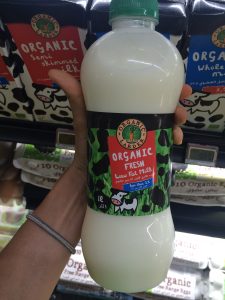
Option #3:
Since the Organic Larder brand of milk may not always be available for purchase, the next available options to consider are the fresh conventional, pasteurized, homogenized milks since they rank higher in my opinion than the sterilized UHT/long life milk – organic or not, which I will never purchase if given the choice.
This is where it gets tricky because all of the common conventional milk brands feed their cows a similar mix of non-GMO grains, have strict testing processes, and by-law do not use growth hormones.
And since the cow’s rations were not clearly communicated (some said it was proprietary information while others said it varied depending on the cow’s age, size and milking status), it is difficult to draw a parallel based on diet alone.
However, given the information that was provided to me, I would rank Marmum as the best option because they made it a point to mention that forages (alfalfa and grass) make up the majority of the ration, which is closest to the cow’s natural diet.
Final Words…
After months of investigative research, I’m relieved to be able to have a more informed opinion about the milk brands in the UAE – research that I have been putting off for over three years.
However, I also realize that I’ve opened a Pandora’s Box and have much more to uncover which may sway my opinion as more information becomes known to me in time.
I would still like to visit each of these farms personally to better understand their pasteurization processes, the feed that they give, and the conditions in which their cows live in.
I would also like to review and compare cow milk to other available sources such as camel and goat milk.
As it turns out, the end of this article is really just in fact a new beginning. Let’s hope it doesn’t take me another three years to finish…
References:
1. http://articles.mercola.com/sites/articles/archive/2009/07/09/the-devil-in-the-milk.aspx
2. http://www.westonaprice.org/health-topics/milk-it-does-a-body-good/
3. http://www.westonaprice.org/know-your-fats/milk-homogenization-heart-disease/
4. http://www.huffingtonpost.com/2014/07/22/pasteurized-homogenized-milk_n_5606168.html
6. http://www.milkfacts.info/Milk%20Composition/Protein.htm
7. http://onlinelibrary.wiley.com/doi/10.1111/1541-4337.12105/pdf
8. http://pubs.acs.org/doi/abs/10.1021/jf00012a013
9. http://www.westonaprice.org/health-topics/ultra-pasteurized-milk/
10. http://www.westonaprice.org/health-topics/faq-dairy/
11. https://draxe.com/pasteurization-homogenization-raw-milk/
12. http://www.westonaprice.org/press/cdc-cherry-picks-data-to-make-case-against-raw-milk
13. http://cspinet.org/new/pdf/cspi_top_10_fda.pdf
14. http://www.westonaprice.org/health-topics/faq-dairy/
15. http://www.idfa.org/news-views/media-kits/milk/definition
Disclaimer
While every care has been taken to ensure the accuracy of the provided information, BerndetteAbraham.com cannot make any guarantees.

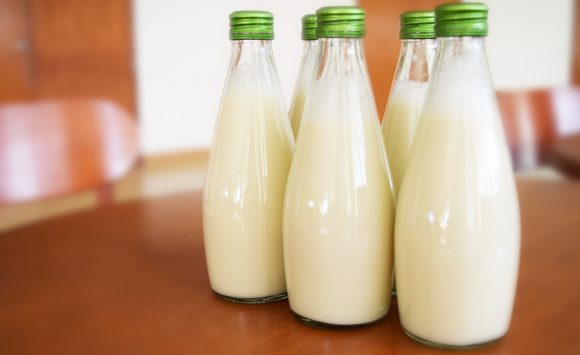
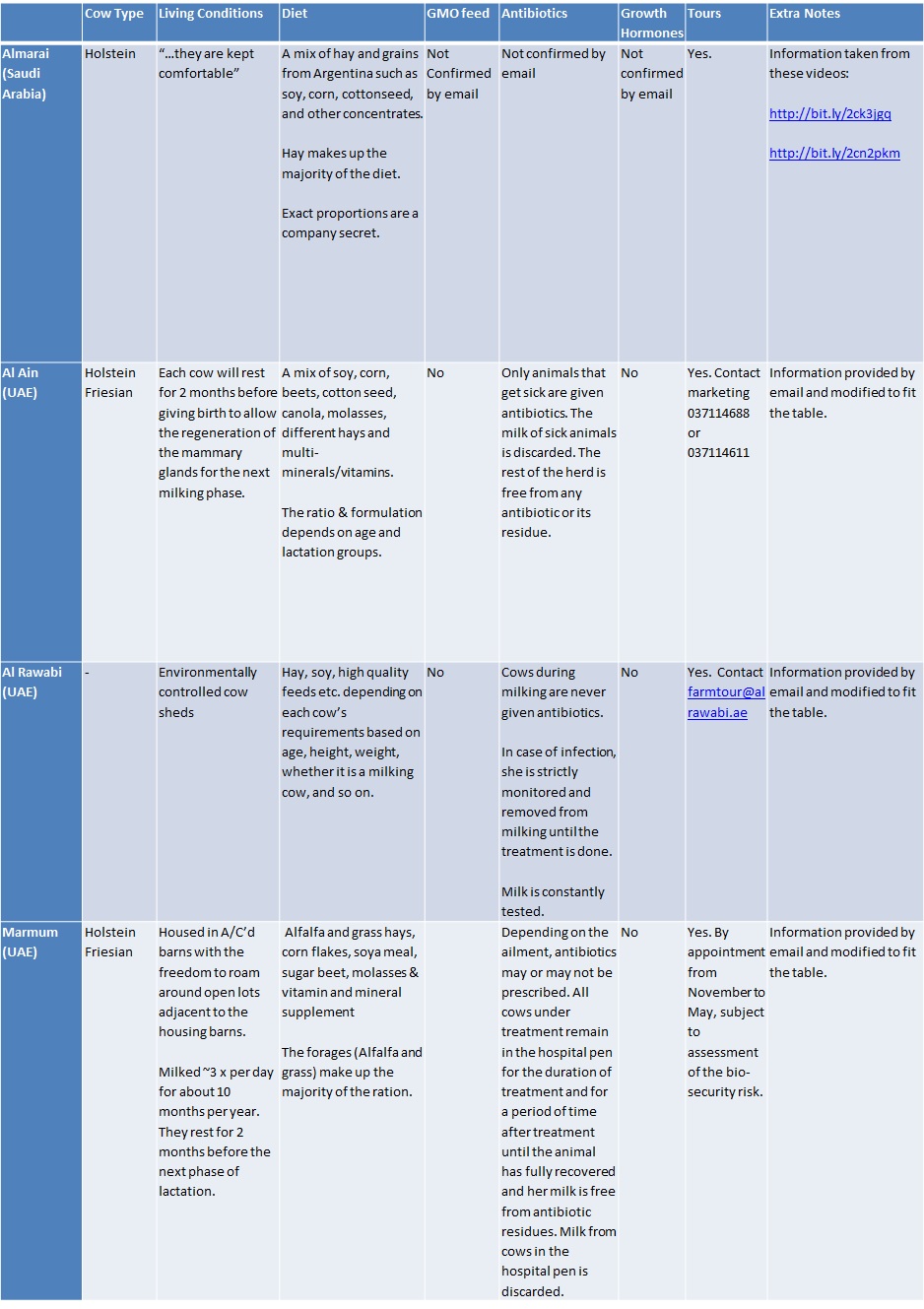
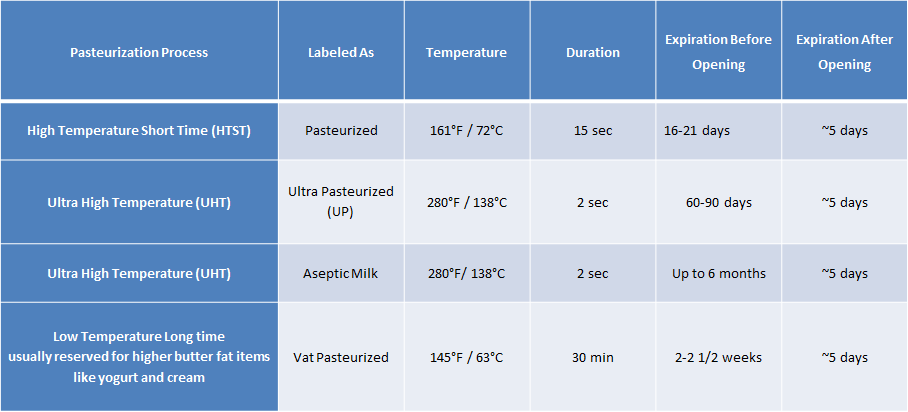
Leave a Reply